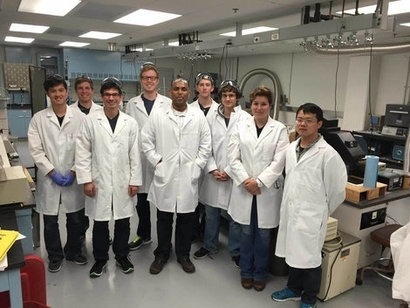
The company is aiming to produce renewable hydrogen using sunlight and any source of water. Its research team had previously reached 1.25 volts, the theoretical minimum voltage needed to split water molecules into hydrogen and oxygen. The new result was recorded at the company’s University of Iowa campus research centre and the team is now seeking to exceed 1.5 volts, the practical voltage needed to effectively split water in commercial systems.
In order to facilitate this process, the Iowa team recently identified a low-cost process that effectively replaces the conventional and expensive vapour deposition process required to make the solar cell component. This also overcomes a critical cost challenge, enabling the company to focus its efforts on developing a complete prototype of a self-contained solar-powered hydrogen production unit with photovoltage more than 1.5 volts. This would in turn form the basis for developing an economic large-scale manufacturing process.
“We are extremely pleased to record voltage samples at such a high level that clearly demonstrate the progress we have achieved in our pursuit of renewable hydrogen fuel” said Tim Young, CEO of HyperSolar. “Our research teams at the University of Iowa and University of California, Santa Barbara, have worked extremely hard to reach this level of performance. We are confident that the recent breakthroughs will bring us significantly closer to building cost-effective real world systems for producing hydrogen at or near the point of distribution using only water and the power of the sun. As commercial adoption widens in consumer markets for fuel cell vehicles and numerous industrial applications, we believe the Company is well-positioned for future licensing efforts and overall product implementation.”
HyperSolar’s ultimate aim is to develop a low-cost and submersible hydrogen production particle that can split water molecules using the power of the sun, emulating the core functions of photosynthesis. Each particle would be a complete hydrogen generator containing a novel high voltage solar cell bonded to chemical catalysts by a proprietary encapsulation coating.
One of the most significant challenges in using hydrogen is transporting it to the point of use, either by trucks or by pipeline. However, the low-cost production of renewable hydrogen wherever there is water and sunlight would be able to address these challenges by eliminating the need for long haul transportation and delivery.
Renewable hydrogen could be connected to a conventional fuel cell to create a self-contained 24/7 renewable electricity generator. During the day the stored hydrogen can be constantly stored as hydrogen but at any time during the day or night it would be converted to electricity through the fuel cell. The 24/7 provision of renewable electricity is something that has, so far, eluded the PV sector, but HyperSolar believes that solar-based renewable hydrogen is the answer to this problem.
The technology could also be used for green motoring in the form of a fuel cell vehicle powered by renewable hydrogen. Charging time could be as fast as a regular vehicle and the only by-product of hydrogen fuel usage is water. Furthermore, the cost of building hydrogen fuelling stations is enormous. However, with a renewable hydrogen generator such as HyperSolar’s H2Generator, standalone fuelling stations could be constructed along any highway where there is water and sunlight. This would enable a large distributed renewable hydrogen production infrastructure to be developed at minimal capital risk.
Additionally, the renewable hydrogen can be easily reacted with carbon dioxide to produce a carbon neutral and renewable form of methane (CH4). This in turn could be used as a direct replacement for traditional natural gas, without fracking, drilling or carbon dioxide emissions.
For additional information:

